 W
WAbe Great Falls is a waterfall in northern Aoi-ku, Shizuoka, Japan, on the upper reaches of the Abe River. It is also sometimes referred to as the Suruga Great Falls or the Otome Falls . It is located near the Umegashima onsen resort area.
 W
WAkiu Great Falls is a waterfall located in Taihaku-ku, Sendai, Miyagi Prefecture, Japan. It is a nationally designated Place of Scenic Beauty. It is one of "Japan’s Top 100 Waterfalls", in a listing published by the Japanese Ministry of the Environment in 1990.
 W
WAtera Seven Falls is a waterfall in the city of Shinshiro, Aichi Prefecture, Japan, on the Atera branch of the Toyokawa River. It is located within the Tenryū-Okumikawa Quasi-National Park. The waterfalls have been protected by the Japanese government as both a Place of Scenic Beauty and Natural Monument since 1934.
 W
WChagama Falls is a waterfall in the Hachimantai district of Kazuno, Akita Prefecture, Japan, on the Yoakeshima branch of the Yoneshiro River. It is one of "Japan’s Top 100 Waterfalls", in a listing published by the Japanese Ministry of the Environment in 1990. The falls have a height of 100 meters, making it one of the tallest on the list of 100 Waterfalls. The falls are also one of the most remotely located on the listing, requiring a hike of 5.5 kilometers across very rough terrain to reach.
 W
WChinda Falls is a double waterfall on the Ōno River in Bungo-ōno, Ōita Prefecture, Japan.
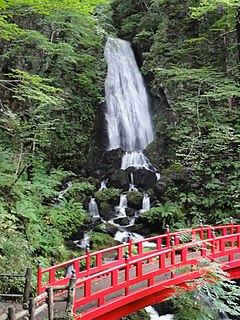 W
WFudō Falls is a waterfall in the city of Hachimantai, Iwate Prefecture, Japan, on a branch of the Api River.
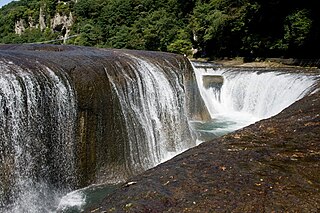 W
WFukiwake Falls is a waterfall located in the city of Numata, Gunma Prefecture, Japan. It is a nationally designated Place of Scenic Beauty and a Natural Monument.It is one of "Japan’s Top 100 Waterfalls", per a listing published by the Japanese Ministry of the Environment in 1990.
 W
WFukuroda Falls is a waterfall located in the town of Daigo, Ibaraki Prefecture Japan. It is a nationally designated Place of Scenic Beauty.and is one of "Japan’s Top 100 Waterfalls", per a listing published by the Japanese Ministry of the Environment in 1990. The falls are ranked as the third most beautiful waterfall in Japan, coming after Kegon Falls and Nachi Falls .
 W
WThe Hagi Falls is a waterfall located in Mount Dodo's small valley in the city of Gifu, Gifu Prefecture, Japan. In 1986, it was named one of Gifu Prefecture's "50 Famous Waters."
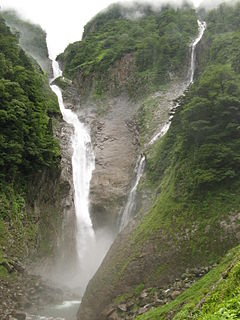 W
WHannoki Falls, in Toyama Prefecture, Japan, is the tallest waterfall in Japan at a height of 497 m. However, it only has water from April to July when the snow covering the Midagahara plateau melts, so its neighbor, Shōmyō Falls, is usually considered the tallest. Hannoki and Shōmyō falls are therefore twin waterfalls.
 W
WHayato Great Falls is a waterfall on the Hayato River within the boundaries of the Tanzawa-Ōyama Quasi-National Park, in Sagamihara, Kanagawa Prefecture, Japan.
 W
WHiji Falls is a National Park and a popular tourist destination on the island and prefecture of Okinawa, Japan. It is located in the northern part of the Okinawa Island, approximately 20 kilometers north of the city of Nago and close to the Yambaru National Park. The falls and the ensuing river flow region tropical most of the year. It is a popular destination for both sightseers and hikers. From start to the finish, the finished trail is about 2 miles, with many steep stairs throughout the path. Camping is permitted with various camp sites. People visiting the area are warned not to swim near the falls because there have been two deaths since 2013 and various falls.
 W
WHottai Falls is a waterfall in the city of Yurihonjō, Akita Prefecture, Japan, on the Akasawa River, a tributary of the Koyoshi River system in the foothills of Mount Chōkai. It is one of "Japan’s Top 100 Waterfalls", in a listing published by the Japanese Ministry of the Environment in 1990.
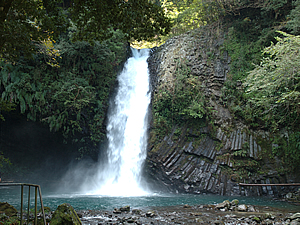 W
WJōren Falls is a waterfall in the Yugashima district of Izu city, Shizuoka Prefecture, Japan, in central Izu Peninsula on the upper reaches of the Kano River. It is a Shizuoka Prefectural Natural Monument. It is one of "Japan’s Top 100 Waterfalls", in a listing published by the Japanese Ministry of the Environment in 1990.
 W
WKamuiwakka Falls is a natural hot spring in Shiretoko National Park, Japan. It is on the Kamuiwakka River.
 W
WKegon Falls is located at Lake Chūzenji in Nikkō National Park near the city of Nikkō, Tochigi Prefecture, Japan. The falls were formed when the Daiya River was rerouted by lava flows. The main falls had a height of approximately 97 metres (318 ft) and about twelve smaller waterfalls are situated behind and to the sides of Kegon Falls, leaking through the many cracks between the mountain and the lava flows.
 W
WKitashōji Falls is a waterfall in northern Yamanashi Prefecture Japan, on the Ishiutoro River, an upper tributary of the Fuji River. It is located in the Minami Alps National Park, in the city of Hokuto. The falls have a width of 35 metres (115 ft) and a drop of 121 metres (397 ft).
 W
WKurokuma Falls is a waterfall in the town of Ajigasawa, Higashitsugaru District Aomori Prefecture, Japan, on a tributary of the Akaishi River, which flows down from the World Heritage Site Shirakami Mountains. It is one of "Japan’s Top 100 Waterfalls", in a listing published by the Japanese Ministry of the Environment in 1990.
 W
WMatsumi Falls is a waterfall in the city of Towada, Aomori Prefecture, Japan, on a tributary of the Oirase River, which flows down from Lake Towada. It is one of "Japan’s Top 100 Waterfalls", in a listing published by the Japanese Ministry of the Environment in 1990.
 W
WNachi Falls in Nachikatsuura, Wakayama Prefecture, Japan, is one of the best-known waterfalls in Japan. With a drop of 133 meters, it is the country's tallest water fall with single uninterrupted drop; however, the tallest waterfalls with multiple drops in Japan are Hannoki Falls, at 497 m (seasonal), and Shōmyō Falls, at 350m.
 W
WNamekawa Great Falls is a waterfall located in the city of Yonezawa, Yamagata Prefecture, Japan, on a branch of the Abukuma River. It is one of "Japan’s Top 100 Waterfalls", in a listing published by the Japanese Ministry of the Environment in 1990.
 W
WNanataki Falls is a waterfall in the Hachimantai district of Kosaka, Akita Prefecture, Japan, on the Kosaka branch of the Yoneshiro River. It is one of "Japan’s Top 100 Waterfalls", in a listing published by the Japanese Ministry of the Environment in 1990. The falls have a height of 60 meters, broken into a series of seven cascades. The falls are easily accessible by car, and are located 8 kilometers from the Kosaka Interchange on the Tōhoku Expressway.
 W
WNanatsu Falls is a waterfall located in the city of Tsuruoka, Yamagata Prefecture, Japan, on a branch of the Bonji River. It is one of "Japan's Top 100 Waterfalls", in a listing published by the Japanese Ministry of the Environment in 1990.
 W
WNaso no Shirataki is a waterfall located in Nikaho, Akita Prefecture, Japan. It became a nationally designated Place of Scenic Beauty in 1932.Although not selected as one of "Japan’s Top 100 Waterfalls", it was included in the listing of the "100 New Tourist Attractions of Japan" in a contest sponsored by the Mainichi Shinbun newspaper in 1950.
 W
WNunobiki Falls is a set of waterfalls near downtown Kobe, Japan, with an important significance in Japanese literature and Japanese art. In Japan, Nunobiki is considered one of the greatest "divine falls" together with Kegon Falls and Nachi Falls.
 W
WOtodome Falls is a waterfall in Fujinomiya, Shizuoka Prefecture, near Mount Fuji, Japan. It is part of the Fuji-Hakone-Izu National Park. Another waterfall, the Shiraito Falls is about a five-minute walk away.
 W
WRyūsō Falls is a waterfall in the town of Ikeda, Fukui Prefecture, Japan, on a branch of the Kuzuryū River.
 W
WRyūzu Falls is a waterfall located upstream from the Yugawa River which makes its way into Lake Yunoko and Lake Chūzenji. It is located near Nikkō in Tochigi Prefecture, Japan.
 W
WSanjō Falls is a waterfall in Hinoemata, Fukushima Prefecture, Japan, on the Tadami River in Oze National Park. It is one of "Japan’s Top 100 Waterfalls", in a listing published by the Japanese Ministry of the Environment in 1990.
 W
WSankai Falls is a waterfall in Zaō, Katta District, Miyagi Prefecture, Japan, in on the Sumikawa River. It is one of "Japan’s Top 100 Waterfalls", in a listing published by the Japanese Ministry of the Environment in 1990.
 W
WSenga Falls is a waterfall in northern Kōfu, Yamanashi Prefecture Japan, on the Arakawa River, an upper tributary of the Fuji River. It is located in the Shōsenkyō canyon, which is recognized by the national government as one of the protected Special Places of Scenic Beauty.
 W
WShasui Falls is a waterfall on the Tanzawa River in Yamakita, Ashigarakami District Kanagawa Prefecture, Japan.
 W
WShiraito Falls is a waterfall in Fujinomiya, Shizuoka Prefecture, near Mount Fuji, Japan. It is part of Fuji-Hakone-Izu National Park and has been protected since 1936 as a Japanese Natural Monument.
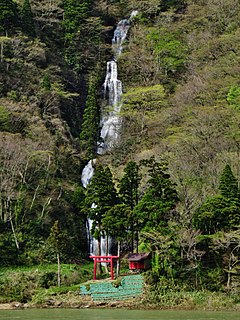 W
WShiraito Falls is a waterfall in the Furukuchi district of Tozawa, Yamagata Prefecture, Japan, on a branch of the Mogami River. It is one of "Japan’s Top 100 Waterfalls", in a listing published by the Japanese Ministry of the Environment in 1990.
 W
WShōmyō Falls are located in the town of Tateyama, Toyama Prefecture, Japan. Shōmyō-daki is the highest waterfall in Japan at 350 m (1,148 ft). The falls have four stages: the first 70 m, the second 58 m, the third 96 m and the last 126 m high. The greatest amount of water flows over the falls in the early mid summer, when the snow in the Tateyama Mountains melts.
 W
WYasu Falls is a waterfall in the Ani district of Kitaakika, Akita Prefecture, Japan, in on the Yoneshiro River. It is one of "Japan’s Top 100 Waterfalls", in a list published by the Japanese Ministry of the Environment in 1990.
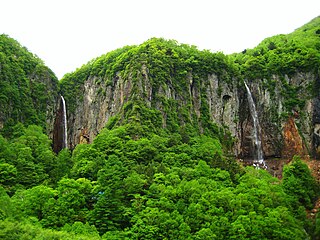 W
WYonako Falls , literally "Yonako Large Waterfalls" ) is a waterfall located in Yonako, Suzaka City, Nagano Prefecture, in the central part of Japan.
 W
WYōrō Falls is a waterfall in Yōrō Park located in the town of Yōrō, Yōrō District, Gifu, Japan.
 W
WYūhi Falls is a waterfall on the upper reaches of Kari river, in western Minamiashigara, Kanagawa, Japan.
 W
W